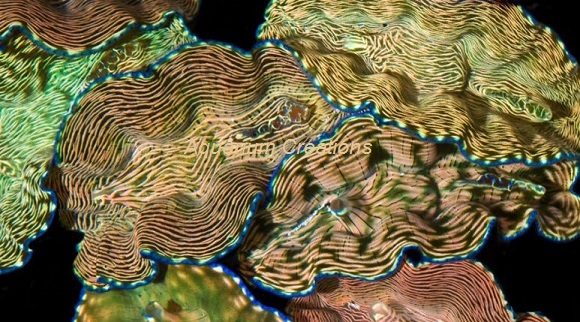Our Striped Blue Rim Deresa Clams differ from the normal Deresa clam with multicolor stripes of orange, green and blue. Our Aquacultured Derasa clams are very popular with aquarists because of their ease of care and fast growth.
The Derasa Clam is also known as the Smooth Giant Clam because of the relative lack of ribbing on the exterior of the shell. It is one of the larger growing Tridacna species and is treasured by aquarists who appreciate an intriguing centrepiece in their reef aquarium. The Tridacna Deresa's thick shell usually has 6 or 7 vertical folds with very low ridges, lacking the rough, concentric sculpture seen in other Tridacna species. As the mantle edges are very symmetrical, it is able to shut its shell incredibly tightly if required. When maintained under ideal conditions, it is not unusual for a Derasa Clam to more than double its size in a year, particularly during the earlier stages of growth.
Clam Placement: Tridacna clams require a mature aquarium, best placed on the sand wherever possible (as long as sufficient light can reach to the sand). Although Derasa Clams must be considered one of the hardier clams to keep in the home aquarium, they do have some special care requirements. The clam should be stable, but never placed in a restrictive crevice that prevents it from opening fully, and it should not be placed in an area of high flow. Too much current will cause the clam to close up, and the zooxanthellae inside the clam will not receive enough light and the health of the animal will deteriorate. In the wild, clams grow with the mantle perpendicular to the sunlight, so they should be placed perpendicular to the aquarium lighting, even though that may result in more of a side-on view for the aquarist. This ensures that none of the mantle loses zooxanthellae, as it is exposed to the light in its entirety. It is not unheard of for clams to move around if they are unhappy where they have been placed, and they should be observed carefully in case they propel themselves into an even more unfavourable position, such as on their sides.
Lighting: In the home aquarium, Derasa Clams require moderate to intense lighting to thrive as they contain the symbiotic algae called zooxanthellae, and receive the majority of their nutrition from the light through photosynthesis. Smaller Tridacna derasa of 3 inch or less in size are more sensitive to intense lighting as their membrane is much thinner than larger Deresa specimens.
Water Flow: Gentle-moderate water movement will be necessary around the clam to ensure that particulate food reaches it and also to make sure that no heavy detritus builds up around the base; but care must be taken to ensure that flow is not too vigorous, the correct balance being crucial to its continued well being.
Diet and Feeding: Beside nutrition coming from photosynthesis, all Tridacna clams are filter feeders and constantly filter the water flowing around them for small particulates. Derasa Clams larger than 3" do not require supplemental feedings as regularly, but smaller than 3" should be fed a phytoplankton or greenwater supplement several times per week. If your Tridacna clams are being maintained in a nutrient poor reef aquarium it would be best to feed larger sizes as well. For an excellent diet additive we recommend AlgaGen PhycoPureT Reef Blend.
Tankmates to Avoid: Avoid any species which would be tempted to nip at the mantle e.g. angelfish, large wrasses, some butterfly fish. Avoid placing the clam too near to stinging corals, particularly those with long sweeper tentacles, and be sure that none of your corals shade out the clam as they grow.
Proper Water Chemistry: Proper water chemistry is important to all Tridacna Clams. Best to keep calcium levels 380 to 450 mg/L, alkalinity levels between 8 to 11 dKH, and the tanks magnesium level between 1280 to 1350 ppm.
Acclimation to tank: Slowly acclimate the clam to your water conditions (drip acclimatisation is best, over the course of around an hour) and then place the clam as low down in the tank as possible, gradually moving it higher over 2 week time periods. It is important that it is not moved repeatedly over less a period of time unless you absolutely have to. Clams have a lot of trouble adapting to changes in lighting and current as it is, and moving them over and over again in shorter time periods can prove very stressful.
Care Level: Moderate
|



